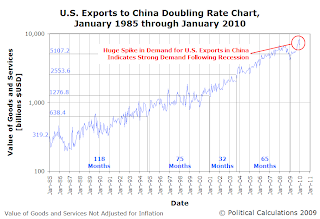
We see the evidence supporting these conclusions in our chart of the trailing year-over-year growth rate of each nation's exports to each other. Comparing each nation's economic recoveries with each others, we find that China's economy is growing much more strongly than the U.S. economy, which is reflected by the soaring year-over-year growth rate of U.S. exports to China following the bottoming of the Chinese recession in approximately August 2009.
What's more, in comparing the average growth rates over time, we see that the margin in favor of the growth rate in the export of U.S. goods and services to China has opened to its widest margin ever with respect to the growth rate of Chinese goods and services to the United States.

U.S. imports from China are following a seasonal pattern, but are showing little growth, which suggests that the post-recession recovery in the U.S. is fairly sluggish.
We confirm these observations in our doubling rate charts showing the level of exports of each nation to the other.
Curiously then, in the face of such conditions already strongly favoring the fortunes of U.S. exporters, the Obama administration has focused its trade diplomacy upon the relationship between the Chinese renminbi and the U.S. dollar, pushing the Chinese government to act to reduce the relative value of the dollar with respect to the Chinese currency by increasing the value of the renminbi.
The policy would seem designed to boost the sluggish economic growth of the United States at the expense of the strongly growing Chinese economy, which is already boosting U.S. exporters without any such intervention thanks to its strong growth. It also suggests that the Obama administration does not have confidence that its economic policies can achieve higher rates of economic growth in the U.S. organically.
One wonders when the apparent lack of confidence by the Obama administration in its economic policies might instead be converted into a realization that the administration's economic policies may be their real problem....
Previously on Political Calculations
- US-China Trade: The Last Three Years, Gone
- China in Recession
- Using International Trade Growth to Diagnose the Economy
- Will China's Economy Burst?
- Why Does Everything Cost So Much More Today?
Labels: trade
Welcome to the blogosphere's toolchest! Here, unlike other blogs dedicated to analyzing current events, we create easy-to-use, simple tools to do the math related to them so you can get in on the action too! If you would like to learn more about these tools, or if you would like to contribute ideas to develop for this blog, please e-mail us at:
ironman at politicalcalculations
Thanks in advance!
Closing values for previous trading day.
This site is primarily powered by:
CSS Validation
RSS Site Feed
JavaScript
The tools on this site are built using JavaScript. If you would like to learn more, one of the best free resources on the web is available at W3Schools.com.
